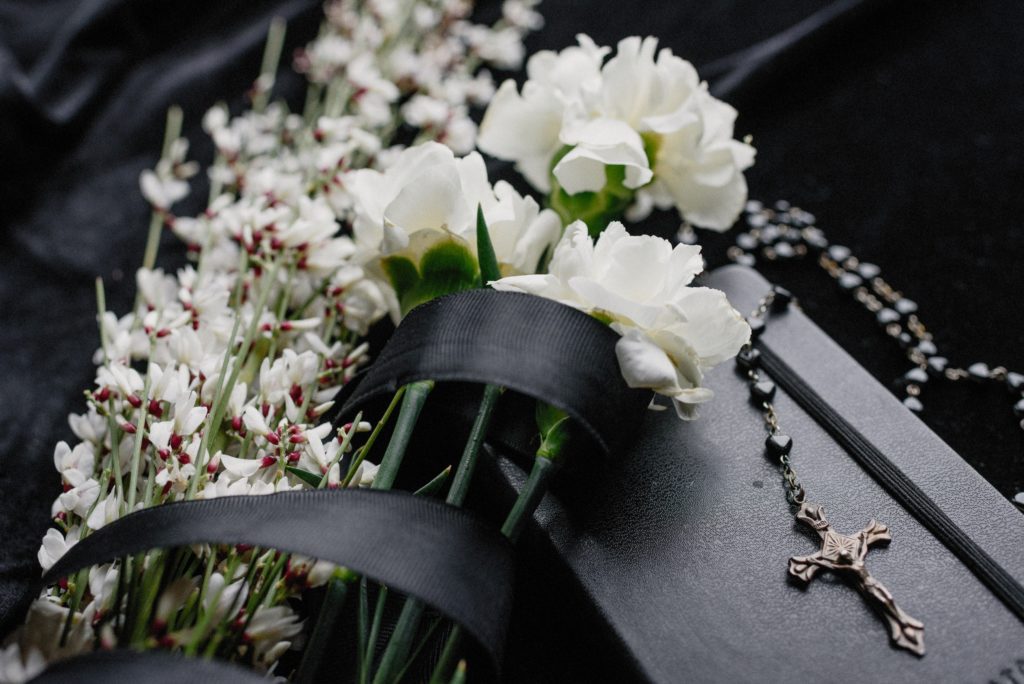No products in the cart.
With so many moving components to a funeral, it’s tempting to just leave the flower arrangements to the florist. Right, as long as it’s the ideal emotional piece? Funeral flowers, on the other hand, have a far deeper meaning. That’s why it’s crucial to know what sorts of funeral flowers and arrangements are appropriate to use or send, as well as what they symbolize.
We’ve put together the complete guide to funeral flowers, with everything you need to know if you’re in charge of planning a lovely send-off for a loved one, or if you’d like to send sympathy flowers to express your condolences.
Flower Arrangements for Funerals
One glance at the altar at a typical funeral reveals that not all floral arrangements are made equal. Everything from a little bouquet to enormous, dramatic blossoms in sweeping patterns may be placed on stands. We’ve highlighted the many sorts of funeral floral arrangements available.
Wreath
Wreaths for funerals may be stunningly lovely. For a dramatic impact, they might be made with a variety of blooms or simply one or two species. In a religious setting, the circular form of a funeral wreath is considered to symbolize the cycle of life or eternal life. Wreaths are an excellent choice for funeral flower arrangements because they’re movable; they can simply be taken from the funeral home and transported to the graveyard to enhance the beauty of both locations.
Cross
A cross is comparable to a funeral wreath, however, it is shaped like a cross rather than a wreath. If the individual who died was very religious, this is a common option.
Casket Spray
Those breathtakingly lovely flowers that cascade across a casket’s top? This is a coffin spray, and no funeral would be complete without it. Casket sprays are frequently constructed with a certain flower (or two) that was particularly important to the person who has died because this arrangement is so near to them. When you enquire about a coffin spray, you’ll frequently hear something like, “Pink roses were Aunt Emma’s favorite.” It is traditional to leave the coffin spray on the graveyard in memory after the burial. You might even give a single flower to a close family member as a keepsake.
Easel Spray
When you think about funeral flowers, an easel spray is perhaps the first thing that comes to mind. It’s the opulent floral arrangement on an easel. The most popular varieties of funeral flowers, such as roses, lilies, and carnations, are frequently used in these lovely arrangements. However, because they’re designed to sit flat against an easel, they’re best viewed from the front alone. If the funeral requires a larger 360-degree arrangement, a basket or vase of flowers may be appropriate.
Basket
A basket is one of the most adaptable funeral flower arrangements, and it’s the ideal way to remember someone who has passed away. Flowers that symbolize death or are commonly used at funerals, such as lilies or gladiolus, are commonly included in basket arrangements. They come in a variety of sizes, from extremely enormous to very little, and are also highly portable.
The Different Types of Funeral Flowers
Are you stumped as to what kind of flowers to use in all those lovely funeral flower arrangements? There’s a lot more to it than you may realize! While there aren’t many hard and fast regulations (though there are certain cultural standards to follow), certain flowers are used at funerals more frequently than others.
Lily
One of the most popular flowers associated with death is the lily. As a result, it’d be difficult to go to a funeral without seeing a lily. “White lilies signify innocence, the renewal of the soul, and purity,” according to 1-800-Flowers.
Carnation
These blossoms are as affordable as they are beautiful, making them an excellent choice for large floral arrangements with a variety of flowers. White is the color of purity, red is the color of love and appreciation, and pink is the color of remembering when it comes to carnations.
Gladiolus
These tall flowers are perfect for sprays, which combine flowers of various heights to create a visually appealing arrangement of sympathy flowers. These lovely flowers, which come in a variety of vibrant colors, are thought to represent the strength of character, which is a lovely tribute to the deceased.
Rose
The rose, being one of the most popular flowers on the planet, has a position among flowers that symbolize death. The deep red color represents grief and is frequently used in funeral flower arrangements, combined with white roses, which represent innocence.
Colors of Flowers and Their Meanings
If the same colors keep showing up at funerals, it’s because these hues have special value when they’re used in funeral flower arrangements—sympathy flowers, as they’re known. We’ll look at some of the most frequent colors used by florists when arranging flowers to be used as memories for funerals in the sections below.
- White: White flowers are the most widely used funeral flowers, whether used alone or in combination with other colors. White flowers are associated with innocence and purity, and practically all of the most widely used flowers at funerals—lilies, roses, carnations, and mums—are white.
- Red: Red flowers, particularly rich, velvety reds such as roses, evoke feelings of love and loss. For funerals, roses are a common choice, but you may also use dramatic red mums or red carnations.
- Yellow: Yellow is a hue that has a generally positive connotation of friendliness. Do you think this bright hue is inappropriate for a funeral? Reconsider your position! At least a dab of yellow may be seen in many of the most heartfelt bouquets. Yellow gladiolus flowers are especially appropriate for funeral flowers.
- Lavender: Lavender flowers, which symbolize respect and humility, are a great addition to a funeral floral arrangement.
- Blue: Blue flowers, the hue of grief, always have a place in sympathy flower arrangements. Popular choices include delphinium and larkspur.


